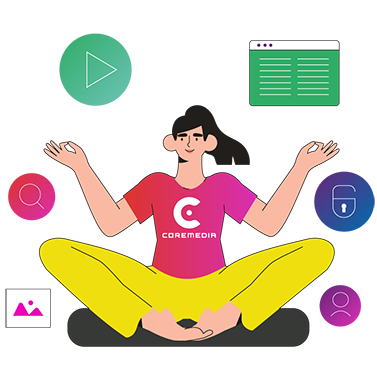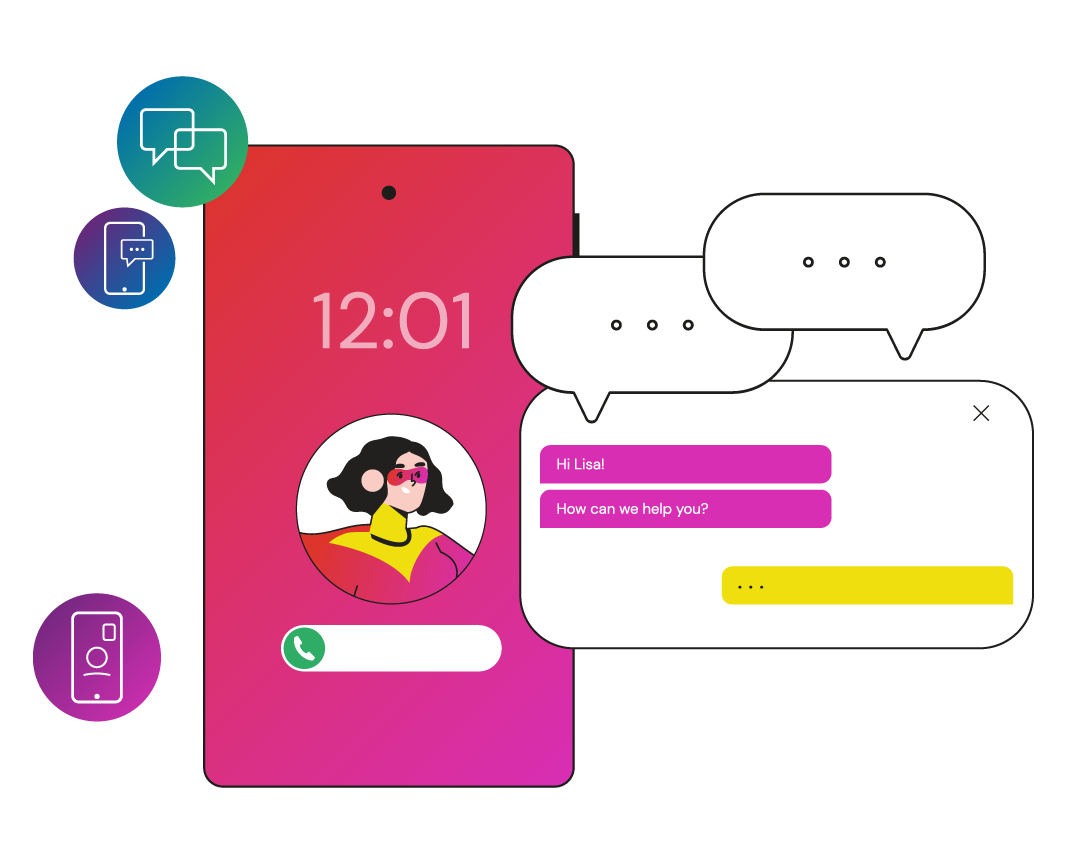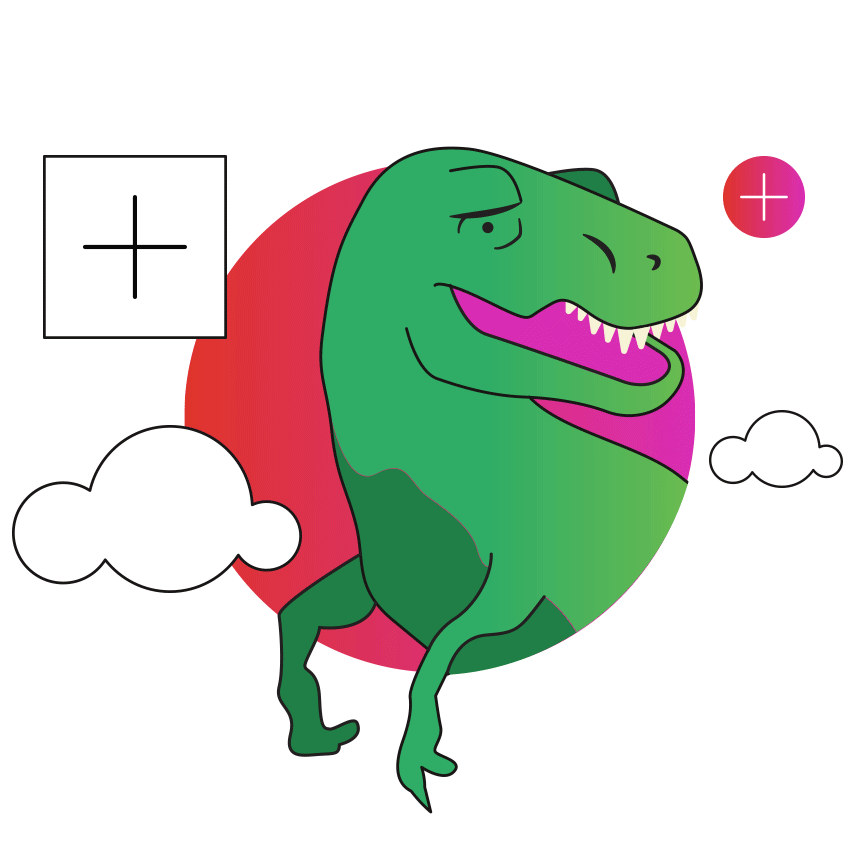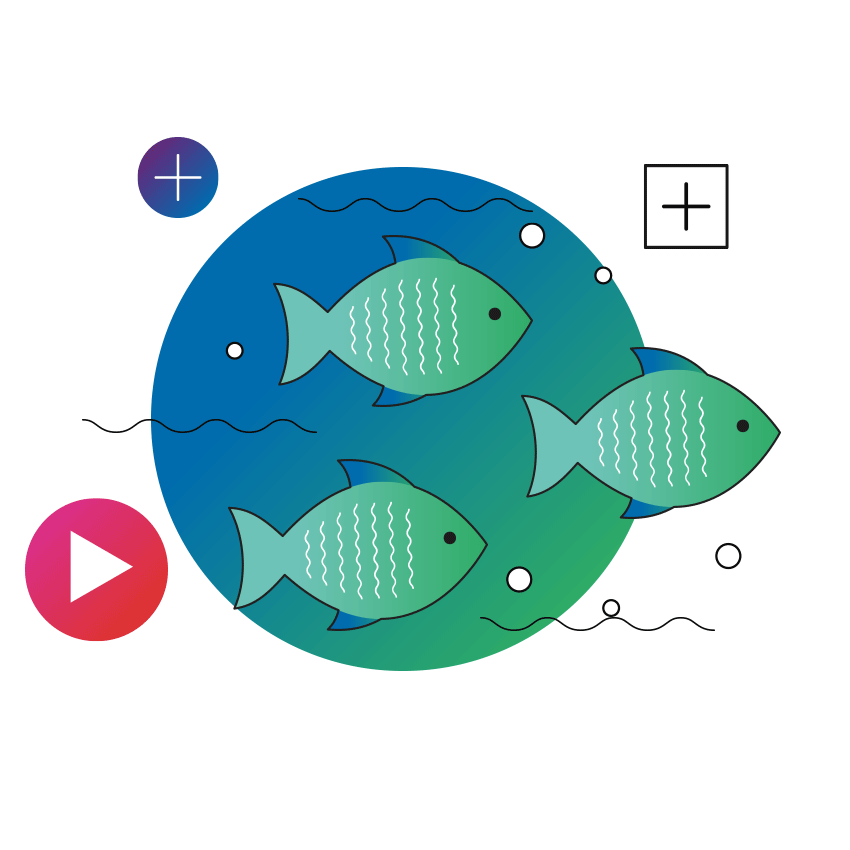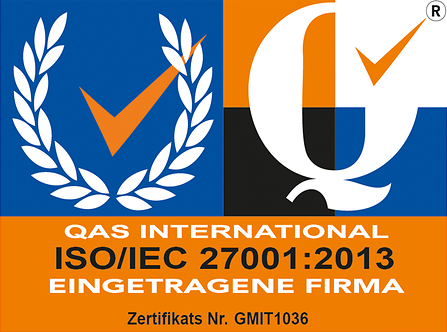These days more of us are working from home and doing more shopping from home. Even with the exciting accomplishment of creating not only one, but multiple vaccines, it will take a while until things are “back to normal.” People even say that many of the changes we’ve made during the global pandemic will stick.
Despite all the challenges, a large set of opportunities have emerged in the last couple years. Shopping online has helped retailers dramatically expand their reach while reducing costs associated with maintaining physical stores in expensive city centers. Going forward, I think we all expect a certain mix of in-store and online shopping, but I expect online shopping will gain more and more momentum.
For retailers, this means a lot of changes and chances. The IT infrastructure must focus on online shopping and become more flexible and agile. The creative heads of brands need to adapt to shopping cultural changes, regularly creating highly anticipated new experiences (we discuss some ideas about this in a previous blog post). The shift to the sit-on-your-couch-while-spending-money shopping style has opened another big opportunity for many retailers: Going global and selling their goods in different countries.
Retailers just starting to expand globally and those already established in-market struggle to find an efficient strategy for the multilingual content that is needed. You might say: “What’s the problem? You just take your original content and replicate it for a country-specific domain and maybe translate the text. Done!”
As many brands quickly learn, going global isn’t that simple. Local markets can have big cultural differences. Sometimes brands sell sub-sets of products to distinct regional markets, so there's a need to adapt the creative content surrounding these products. Software and products can differ globally – for example, electronics require different security certifications, labels, and power supply specifications. Legal aspects like copyright and GDPR need to be considered. For these new markets, many retailers want or need to address different users with multilingual targeted campaigns. This points to one thing: The content must adapt for different cultures, not just the language and the currency. In these cases, we must consider localization instead of a plain translation between two or more languages.
We also have scenarios where translation and localization are not required, but content needs to be synchronized for global audiences in multiple countries. A classic example is making a site for the German market available for German-speaking Swiss and Austrian users. The catalog, promotions, and campaigns may be the same, but small country-specific pieces for copyright and shipping and handling are required.
In summary, we’re talking about two different kinds of processes for website localization: Synchronization within the same language and localization with or without additional content adjustments.
Tanslation Workflow Screenshot
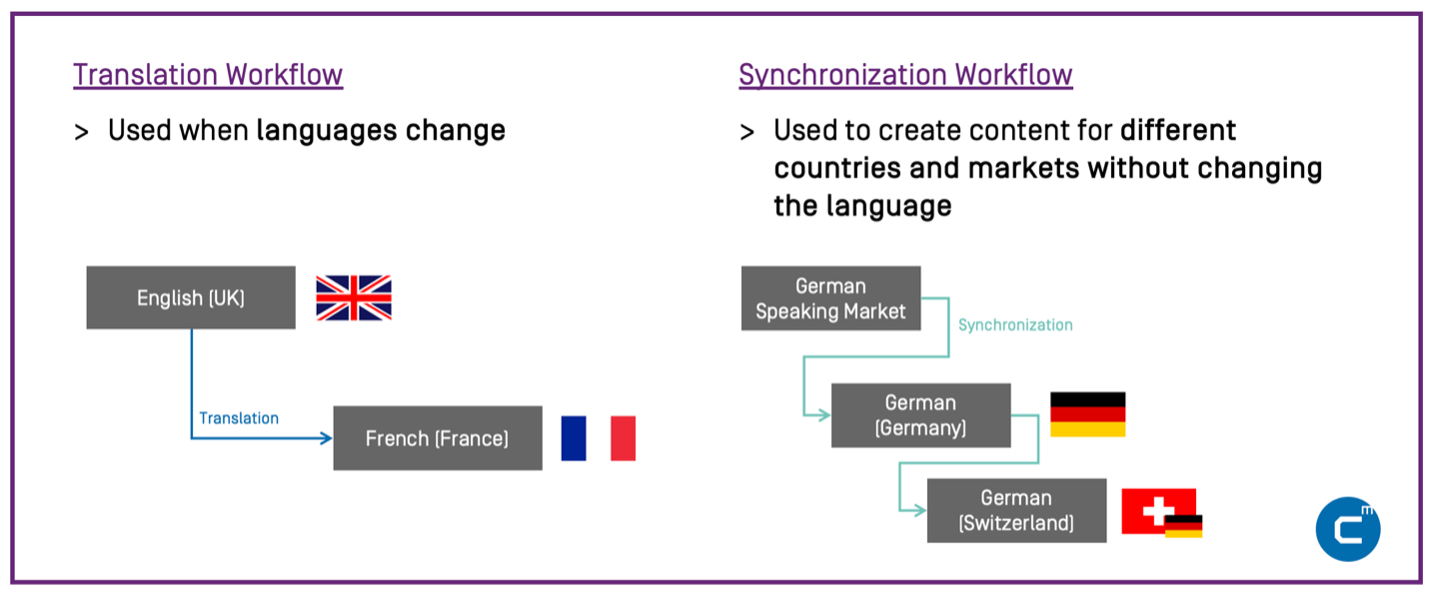
Figure 1: Translation vs. Synchronization
Having more content or multilingual variants significantly enlarges the editorial team’s workload. More content must be produced, and a single campaign quickly becomes a bigger effort than originally expected. If creativity is the driver for success, efficiency becomes the tool to survive! Brands need to identify a scalable strategy for content roll out, cross-locale reuse and – most importantly - a tool that makes the process as easy and efficient as possible.
Three Possible Multilingual Strategies for Global Markets
When getting started with basic concepts, it’s important to first discuss the hierarchy of translated or localized websites. As a rule of thumb, you want to minimize translations and leverage more synchronizations.
Translations are usually expensive, time-consuming, and error prone. To translate content properly, you either need a linguist or a translation tool to do the work for you. One way or the other, once the translation is completed, your team still has to perform a quality check. This can be tricky, since the editor can’t always verify that the text in different languages is properly translated – it’s more of a check of the optics. Hence, the translation might seem to be correct according to a dictionary, but many words have different meanings based on context. In comparison, synchronized content is less expensive to maintain because you only have to verify the original content once.
So, what’s the best strategy to minimize translation and localization and maximize synchronization? In general, there are three basic approaches:
- Country-first
- Language-first
- Grouped
For all these strategies, you first need to gather a few details:
- What are the countries and languages within these countries that you want to serve content to?
- What are your priority locales and languages? What are your secondary priorities?
- How big is your editorial team? What are your capabilities to create and manage multilingual content?
- Do you have different content strategies for your different markets?
Your beachy sandals won’t sell as well in Iceland as they do in South Florida. So, if your content differs that much between target markets, you might want to consider building the localization hierarchy only for parts of your content. As you can see, there’s a lot to consider when it comes to content localization. Let’s learn about each strategy.
Country-First Strategy
The name already gives it away. With the country-first approach you organize the hierarchy of locales around each country, independent of the language at first glance.
You start with one parent site. Most use either the page of your company’s country of origin or the country of your biggest market. That is fine, let’s use that as our starting point! Now, let’s collect all the countries you want to address with their own site. This is our first level and usually defines the domain URLs for each website. Next, define the countries and languages you want to deliver product pages to - these are your second level. Lastly, collect all other language variants that you want to serve content in for your target countries.
Below is an imaginary example for a retailer that originated in Spain and recently expanded to the French and Swiss markets. Now they want to reach out to Germany and better serve the non-French speaking audience in Switzerland. Following the country-first approach, you can see that the translations quickly add up. At the same time, just looking at the French and German content, we see potential for synchronization to replace expensive translations.
While our imaginary retailer is still growing, they don’t have editorial teams yet in Switzerland or Germany. This isn’t a big issue for the French version of the Switzerland site since the French team can help out. But it becomes a problem for the other two language versions: German and Italian. You can already hear the Euro coins clinging when our retailer has to pay a translation agency or hire local translator.
Tanslation Workflow Screenshot
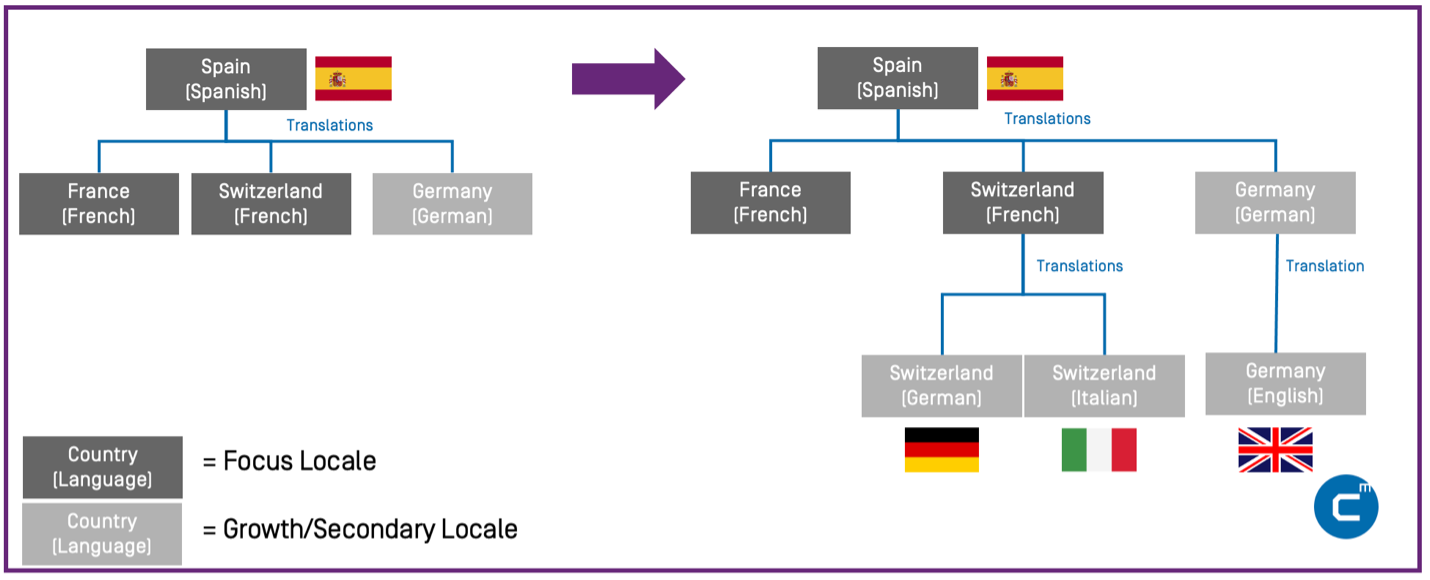
Figure 2: Country-First Example
Furthermore, let’s look ahead: In two years, our retailer wants to expand to Italy. They already have Italian content, via the localized version of the Switzerland site, and it would be easy to synchronize that site. While that is true, what if you want to address this local audience differently than the other European sites using a new creative concept? It’s not simple and the devil is in the details. In summary, the country-first option is not really efficient for our retailer to reach his new audiences.
But when is it a good fit? Ideally, whenever you have a different set of products and content or simple independent sites for each country. Often, this is the case if you have editorial teams in each of the other markets who directly manage their language sites.
Language-First Strategy
It’s very obvious what this option favors: aligning around the language.
The first step is the same as the country-first strategy, defining your parent locale. Choosing based on your country of origin or the language you use most across all countries - both are good starting points.
Next, identify all of the languages that you serve content to. For each language, define the country that is your main audience – for example, the international market that you focus on and where you earn the most revenue. Voilà! You have your second level. Last but not least, synchronize your language-driven preferred locales to all country-specific versions.
Tanslation Workflow Screenshot
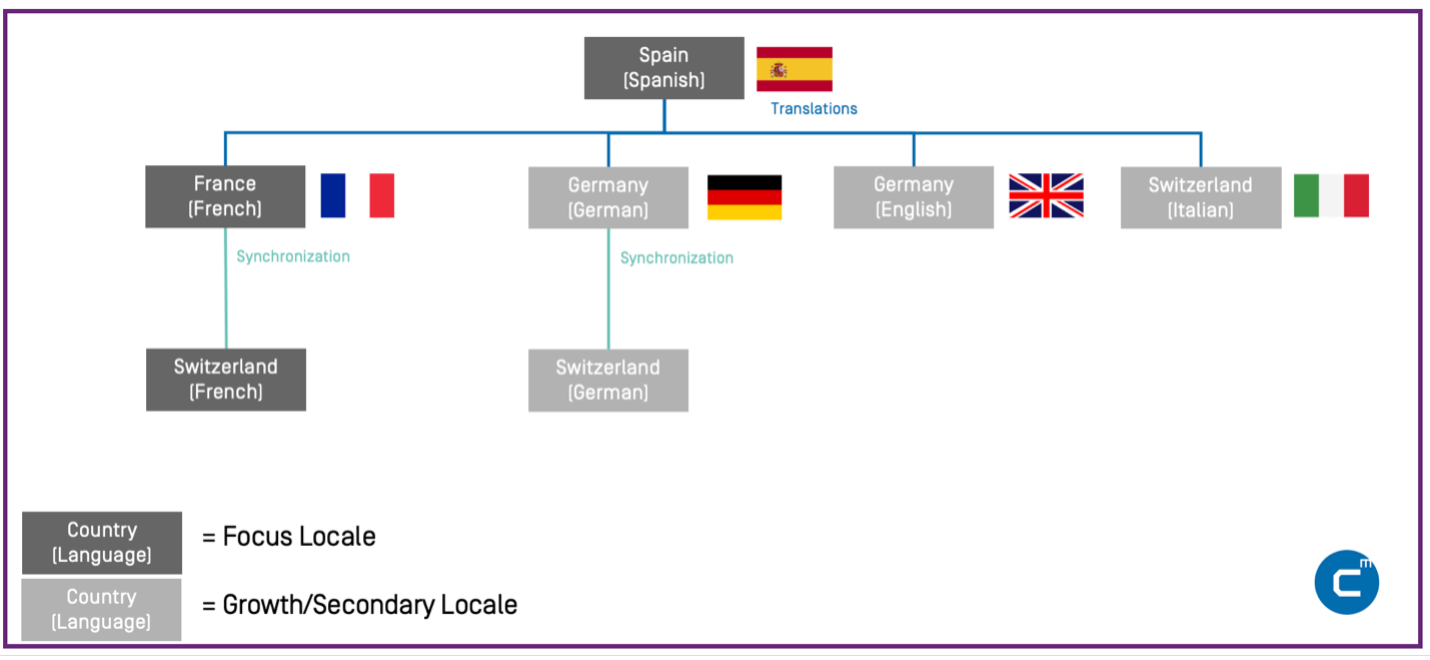
Figure 3: Language-First Example
You can see how that change in strategy changes the picture: we “converted” two costly translations into synchronizations!
Let’s consider again that the retailer wants to expand into the Italian market. Adding a less expensive synchronization workflow into the mix is now relatively easy since we already have the Italian site for Switzerland. At this point you have the flexibility to make the site for Italy the predominant country over Switzerland or add Italy as a “child” of Switzerland. That decision should be based on your content and where your content will be changing the most. Ask yourself – how much will the content differ? Which would be more likely to change more often than the other?
If you want to offer languages that are spoken in many countries that your organization targets, the language-first approach can be beneficial. You can save money by replacing expensive translations with simpler synchronizations, which are much easier for smaller and more centralized editorial teams to manage. However, this strategy loses its effectiveness if you need very country-specific content.
Grouped Strategy
The grouped strategy allows you to group locales based on several criteria, such as currency, marketing strategy, branding differences, region or language. For this strategy, several locales can be grouped based on an indicator that the company values and is driving the content strategy.
Using our simple example, a grouped approach with a focus on several languages looks like this:
Tanslation Workflow Screenshot
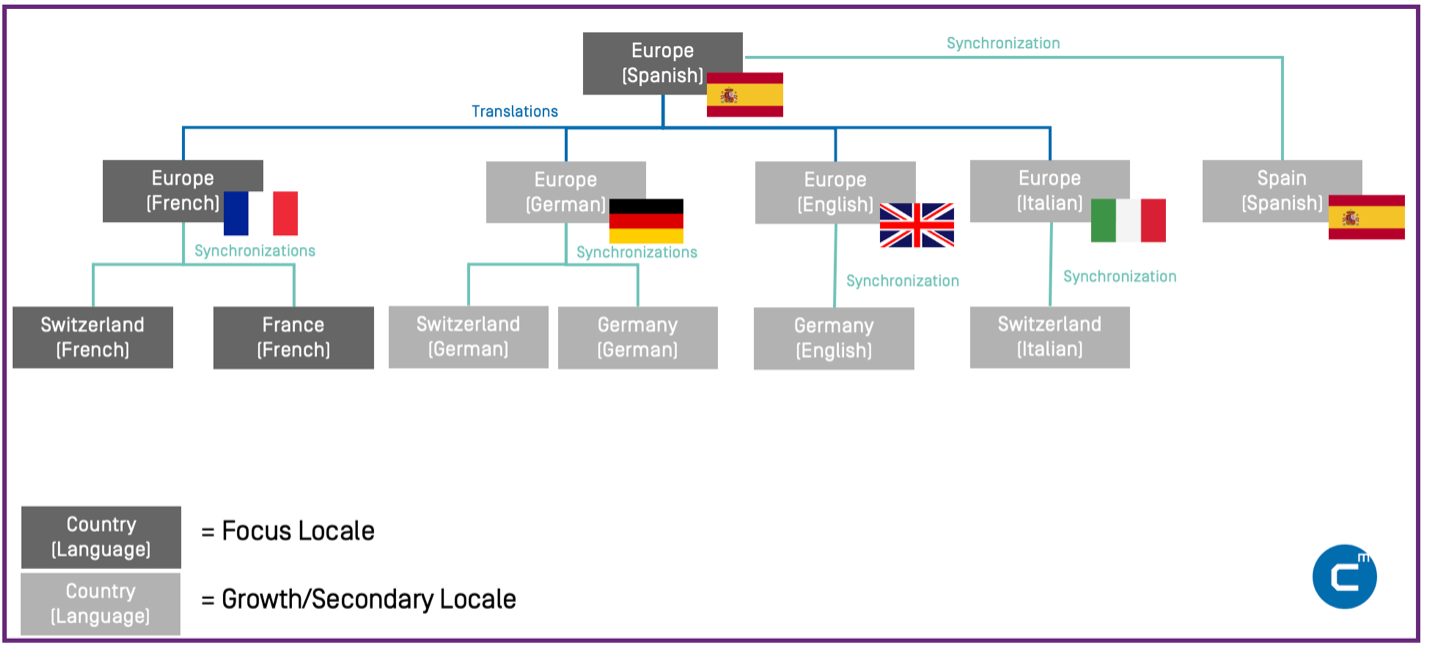
Figure 4: Grouped Example
The groups are structuring the hierarchy and have artificial group parents to allow for easier expansion. These artificial site layers create standardized access points where further locales can be added.
As you can see, there are far more sites to manage than with the language-first approach. But if we focus our grouping around language, is the Italian site for Italy the parent for the Italian site for Switzerland or vice versa? Here they are all inherited from THE Italian site. And if you consider other countries that speak Italian as an official language, such as Slovenia or Croatia, we can simply attach their sites directly to the Italian page. In this example, language is the driver for defining a region since the organization prioritizes minimizing website localization.
A similar concept could work for an international brand that has historically used different brands for different regions. While all brands originate with the same company that makes the same products and uses the same manufacturers, each brand has an artificial “site” and is localized based on the artificial node.
In general, the grouped approach gives you the most flexibility in the future since it reduces the potential for unexpected rearrangements in the hierarchy when market focus changes.
A More Complex Global Comparison
In our earlier examples, we focused on a small setup in the European market to explore the strategies. Envision the same concepts if you also include locales from Asia or the Americas!
Let's dive into these more complex variations. Here, we aim to handle 26 global locales. Let’s start with the country-first approach again. You can see one difference here: instead of using the origin as a locale, the retailer choses an artificial root-node for English to not prioritize any country.
Tanslation Workflow Screenshot
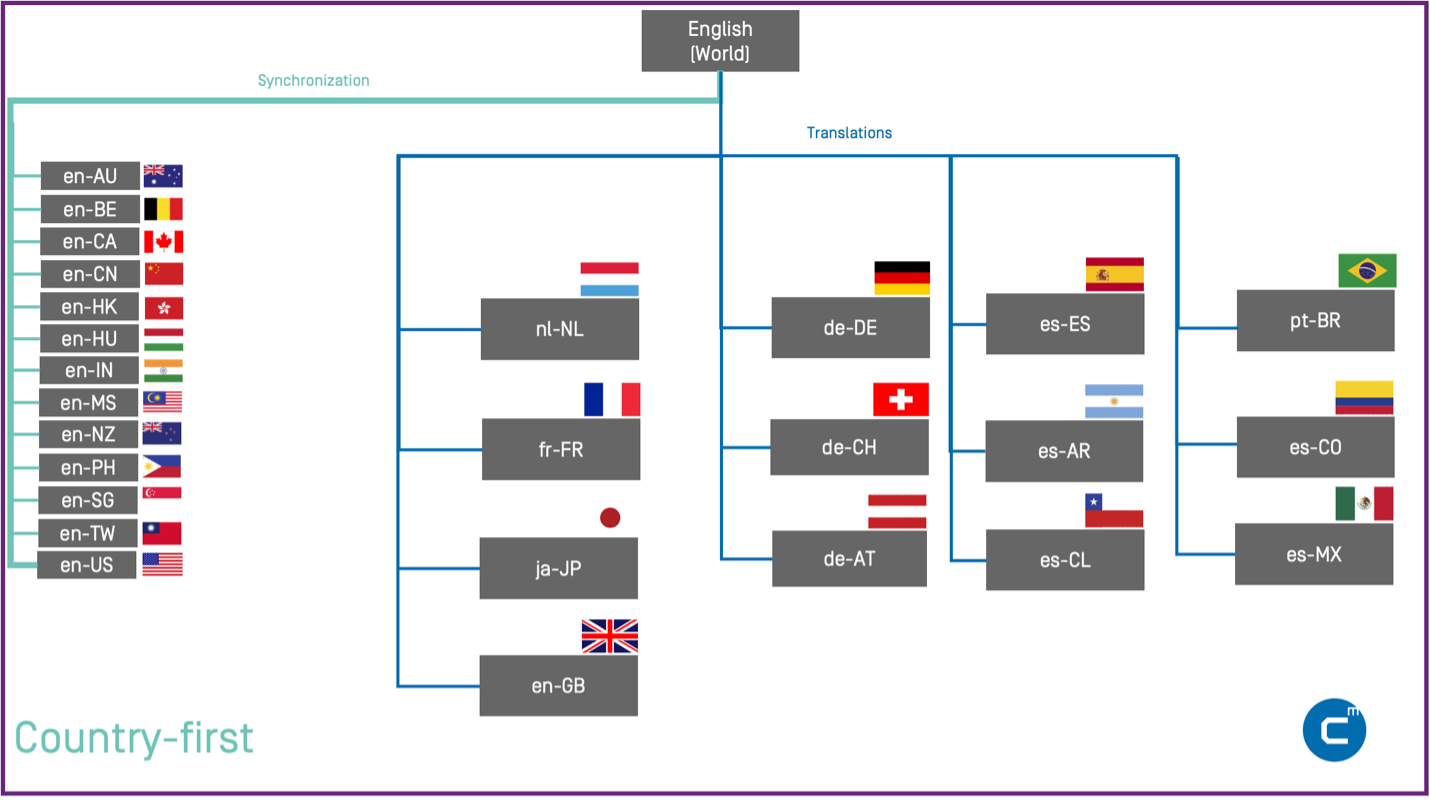
Figure 5: Complex Country-First Example
Applying the language-first strategy to the same setup and still maintaining the neutral English root node, we can see that a lot of translations were exchanged for synchronizations.
Tanslation Workflow Screenshot
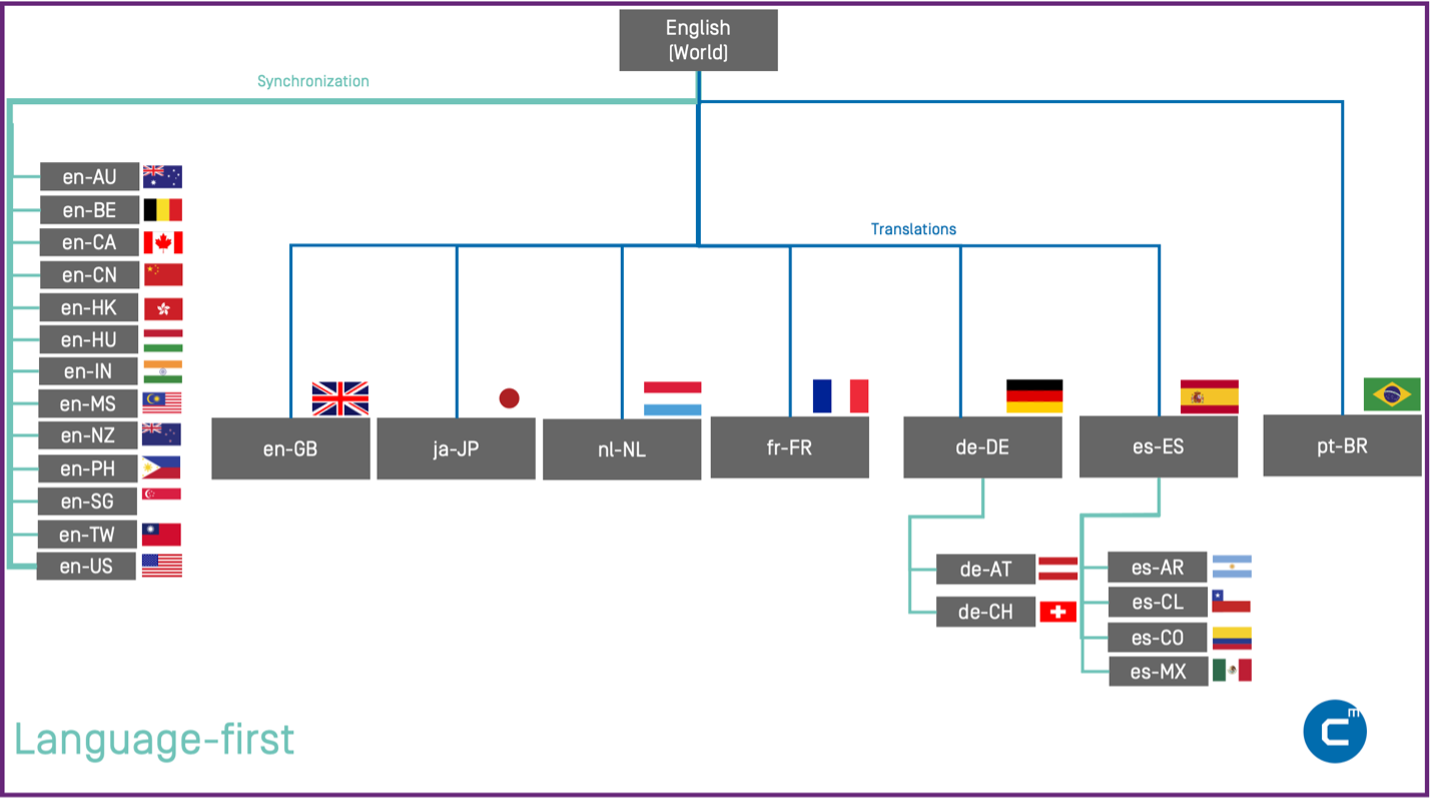
Figure 6: Complex Language-First Example
Finally, let’s use the same setup for a partially grouped approach. The hierarchy only changes a bit but doesn’t favor any country over the other.
Tanslation Workflow Screenshot
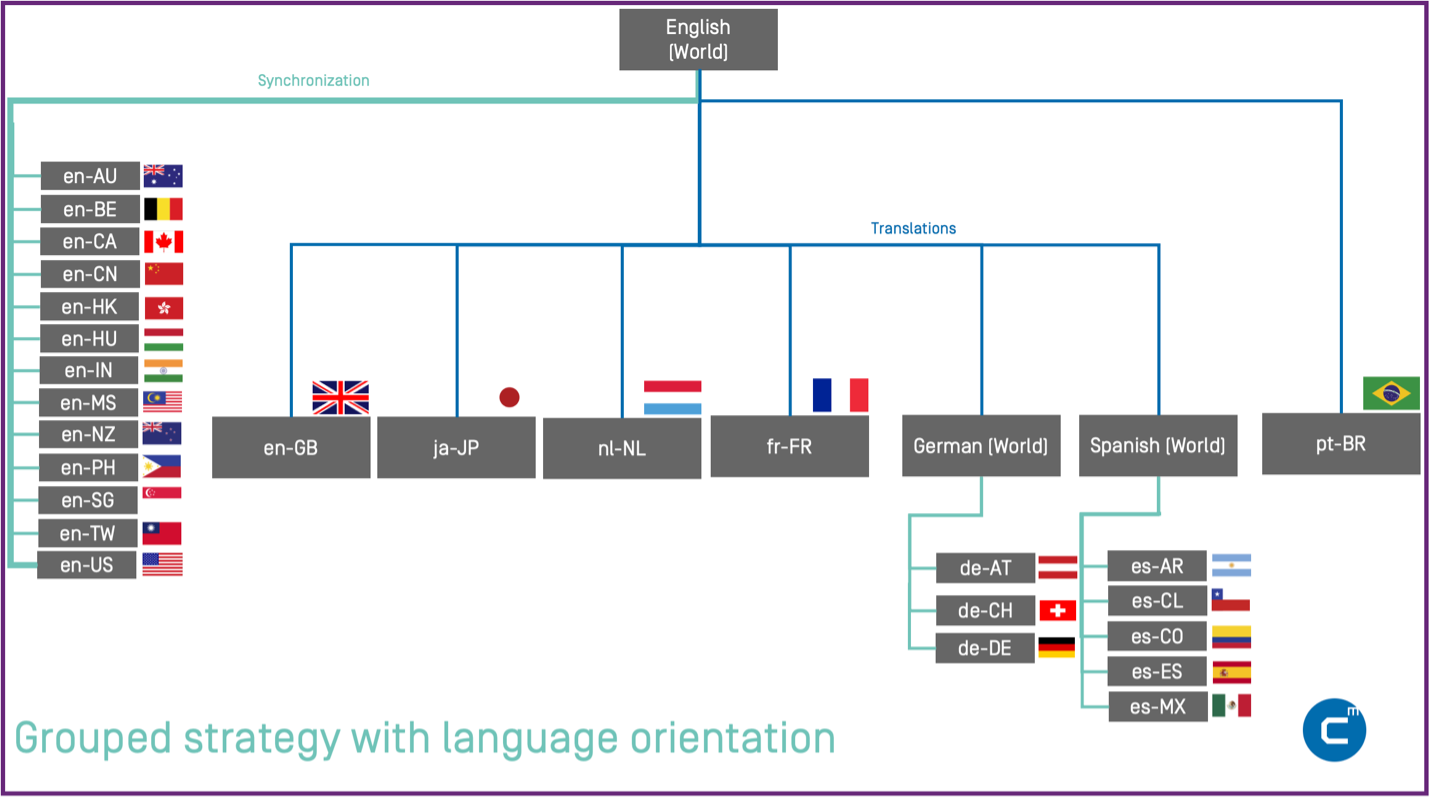
Figure 7: Complex Grouped Strategy Example
Granted, many factors influence the multilingual setup. Growth and history are always drivers that impact the whole analysis. But let’s make it simple and just compare translations and synchronization to learn which multilingual strategy is the best for our complex scenario.
| Type | Translations | Synchronizations |
| Country-First | 13 | 13 |
| Language-First | 7 | 19 |
| Grouped | 7 | 21 |
Here we have a clear winner: The Language-First approach!
Considerations for Your Multilingual Website
There is so much to consider and so many influencing factors when considering a website localization strategy. This can make it hard to decide and stick to one strategy. And maybe we shouldn’t stick to just one – we should focus on what brings the most value for the organization and the audiences in their new markets.
Many aspects can be examined, including:
- Do you use manual translation or automated services?
- How many workflows can your tech stack support?
- How complicated is it for your editorial team to keep track of the hierarchical relationships?
- How can you track progress of each workflow?
- How can you identify errors?
- How would the concept work if you remove a dedicated locale?
- Can you convert a translated site into a synchronized site and vice versa?
Most of these questions are tied to your tech stack and specifically what your Content Management System can do to support you every day.
Of course, each strategy doesn’t need to be followed religiously and changing needs will often throw your perfect approach into a spin. So also consider your company’s long-term strategy on growing and expanding in new markets.
At CoreMedia, we have extensive experience with localization and bringing value to global organizations. Many of our customers operate worldwide, with some serving over 150 locales.
If you are interested in learning more about localization or would like to see a demo of CoreMedia Content Cloud in action, please contact us.
